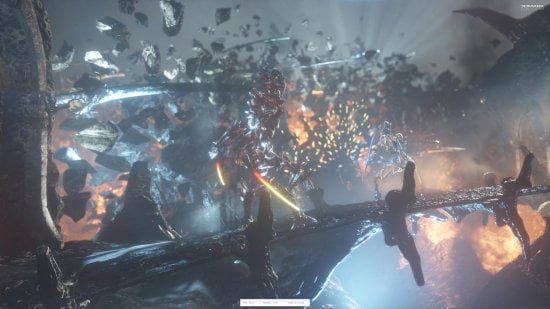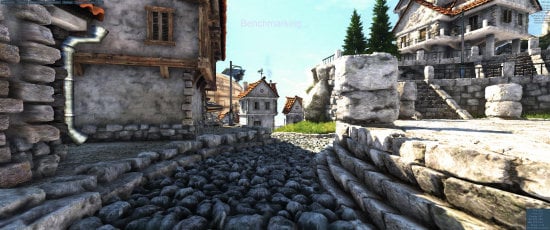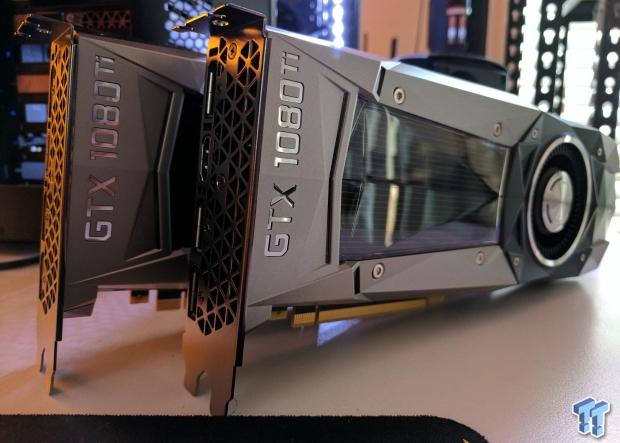Intro & System Specs
It has been a crazy busy last 6-12 months for me, with the amount of travel I do (every event is a minimum 25-hour one-way flight), and I have been on 12 trips in the last 12 months, but I have slowly rebooted the entire GPU side of TweakTown. I've built multiple new systems and retested most of my graphics cards in 4 different resolutions - as well as multi-GPU testing in a separate system.
There are 2 high-end new test beds, 3 monitors (including a 3440x1440 panel for UltraWide testing) - and some beautiful, ridiculously fast components in between. We've added some new benchmarks to the roster, used some of the latest drivers, and are continuing to add and refine all of our included benchmarks. There are new ones coming soon that we'll be throwing in right away, especially when I want to test Vulkan and DX12 to their full potential - in single, and multi-GPU situations.
I have a 5K display that will be here in the next two weeks, which rocks a native resolution of 5120x2880 - up from the 3840x2160 offered on 4K. This is something I was pushed to do when testing NVIDIA's new GeForce GTX 1080 Ti, as it's just so damn powerful - but in SLI? I really need 5K to begin pushing it, as GTX 1080 Ti SLI can run 4K 60FPS without a problem - as long as the game supports SLI.
Before I started testing the GeForce GTX 1080 Ti cards in SLI, I decided to use the new AMD Ryzen 7 1800X test bed, to stress out the motherboard and see how well AMD's latest processor handles two of the fastest graphics cards ever made, in SLI. The answer is: it handled it perfectly, and we are working on Core i7-7700K tests to compare against the Ryzen 7 1800X.
At the same time, I decided that I would test the previous 'Ti' release - NVIDIA's Maxwell-based GeForce GTX 980 Ti. The GTX 980 Ti is still a great graphics card, handling even 3440x1440 pretty smoothly for a previous-gen card - but in SLI, the GTX 980 Ti is potent. We will be adding Radeon RX 480 cards in CrossFire to these charts soon, as they're a work in progress - we'll have another article out with some comparisons of Polaris against Maxwell and Pascal, all on Ryzen 7 1800X.
System Specs
The system that I'm using is my new workstation/gaming PC, something I built last week. For the last week we've been fine tuning benchmarks, and stressing out every card I own on the Ryzen 7 1800X and the ASUS Crosshair VI Hero motherboard.
I'm using the 1TB OCZ RD400 NVMe M.2 SSD, which is super-small, ridiculously fast M.2 SSD that pushes 2600MB/sec read and 1600MB/sec writes.
AMD's new Ryzen 7 1800X processor is cooled by the Noctua U12S SE-AM4.
GTX 980 Ti SLI vs GTX 1080 Ti SLI specs
Can you believe it has been nearly two years since NVIDIA released its GeForce GTX 980 Ti graphics card? NVIDIA used the Maxwell GPU architecture on the 28nm process with great success, with a power efficient graphics card that still packed a huge performance punch - especially over the stock GTX 980.
But just 12 months later NVIDIA trumped the GTX 900 series with its new GeForce GTX 1080 and GTX 1070 Founders Edition graphics cards, powered by the new Pascal GPU architecture and on the 16nm node. Larger performance leaps alongside leaps and bounds in memory bandwidth and technology used saw the GTX 1080 become the enthusiast graphics card of choice for high-end gamers.
NVIDIA completely dominated the high-end graphics card space in 2016, with various AIB partners releasing their custom GeForce GTX 1080 graphics cards - with even more performance, cooler running cards, and multiple fans with higher OC abilities.
Then came GDC 2017, and NVIDIA unveiled the new GeForce GTX 1080 Ti - which like the GTX 980 Ti before it, represents a huge leap over the GTX 1080.
NVIDIA itself markets the new GeForce GTX 1080 Ti as the best Ti release ever, with an average 35% more performance over the already fast GTX 1080.
As you can see, the GTX 1080 Ti really rocks that 11GB of GDDR5X @ 11Gbps well, offering some monster memory bandwidth numbers.
Benchmarks - Synthetic
3DMark Fire Strike - 1080p

3DMark has been a staple benchmark for years now, all the way back to when The Matrix was released and Futuremark had bullet time inspired benchmarks. 3DMark is the perfect tool to see if your system - most important, your CPU and GPU - is performing as it should. You can search results for your GPU, to see if it falls in line with other systems based on similar hardware.
3DMark Fire Strike - 1440p
3DMark has been a staple benchmark for years now, all the way back to when The Matrix was released and Futuremark had bullet time inspired benchmarks. 3DMark is the perfect tool to see if your system - most important, your CPU and GPU - is performing as it should. You can search results for your GPU, to see if it falls in line with other systems based on similar hardware.
3DMark Fire Strike - 4K
3DMark has been a staple benchmark for years now, all the way back to when The Matrix was released and Futuremark had bullet time inspired benchmarks. 3DMark is the perfect tool to see if your system - most important, your CPU and GPU - is performing as it should. You can search results for your GPU, to see if it falls in line with other systems based on similar hardware.
Heaven - 1080p

Heaven is an intensive GPU benchmark that really pushes your silicon to its limits. It's another favorite of ours as it has some great scaling for multi-GPU testing, and it's great for getting your GPU to 100% for power and noise testing.
Heaven - 1440p
Heaven is an intensive GPU benchmark that really pushes your silicon to its limits. It's another favorite of ours as it has some great scaling for multi-GPU testing, and it's great for getting your GPU to 100% for power and noise testing.
Heaven - 4K
Heaven is an intensive GPU benchmark that really pushes your silicon to its limits. It's another favorite of ours as it has some great scaling for multi-GPU testing, and it's great for getting your GPU to 100% for power and noise testing.
Benchmarks - 1080p
1080p Benchmarks
Rise of the Tomb Raider is one of the best looking games on the market, a truly gorgeous game - and a wonder to benchmark. The team at Crystal Dynamics made a very scalable PC game that plays really well testing graphics cards. We've got DX11 and DX12 results in one here, showing the slight strengths of running DX12 mode.
Rainbow Six: Siege has been a strong entry into the franchise, popular for its realistic feel and great graphics. Stable as a rock for benchmarking, right up to 3440x1440 and 4K.
Middle-earth: Shadow of Mordor is one of the most graphically intensive games we test, with Monolith using their own Lithtech engine to power the game. When cranked up to maximum detail, it will chew through your GPU and its VRAM like it's nothing.
You can buy Middle-earth: Shadow of Mordor at Amazon.
Metro: Last Light Redux comes from developer 4A Games, making the Redux version of Metro: Last Light the 'definitive' version of the game. Redux had a fresh coat of paint on the already impressive 4A Engine, and it really pushes our GPUs to their limits.
You can buy Metro: Last Light Redux at Amazon.
Benchmarks - 1440p
1440p Benchmarks
Rise of the Tomb Raider is one of the best looking games on the market, a truly gorgeous game - and a wonder to benchmark. The team at Crystal Dynamics made a very scalable PC game that plays really well testing graphics cards. We've got DX11 and DX12 results in one here, showing the slight strengths of running DX12 mode.
Rainbow Six: Siege has been a strong entry into the franchise, popular for its realistic feel and great graphics. Stable as a rock for benchmarking, right up to 3440x1440 and 4K.
Middle-earth: Shadow of Mordor is one of the most graphically intensive games we test, with Monolith using their own Lithtech engine to power the game. When cranked up to maximum detail, it will chew through your GPU and its VRAM like it's nothing.
You can buy Middle-earth: Shadow of Mordor at Amazon.
Metro: Last Light Redux comes from developer 4A Games, making the Redux version of Metro: Last Light the 'definitive' version of the game. Redux had a fresh coat of paint on the already impressive 4A Engine, and it really pushes our GPUs to their limits.
You can buy Metro: Last Light Redux at Amazon.
Benchmarks - 4K
4K Benchmarks
Rise of the Tomb Raider is one of the best looking games on the market, a truly gorgeous game - and a wonder to benchmark. The team at Crystal Dynamics made a very scalable PC game that plays really well testing graphics cards. We've got DX11 and DX12 results in one here, showing the slight strengths of running DX12 mode.
Rainbow Six: Siege has been a strong entry into the franchise, popular for its realistic feel and great graphics. Stable as a rock for benchmarking, right up to 3440x1440 and 4K.
Middle-earth: Shadow of Mordor is one of the most graphically intensive games we test, with Monolith using their own Lithtech engine to power the game. When cranked up to maximum detail, it will chew through your GPU and its VRAM like it's nothing.
You can buy Middle-earth: Shadow of Mordor at Amazon.
Metro: Last Light Redux comes from developer 4A Games, making the Redux version of Metro: Last Light the 'definitive' version of the game. Redux had a fresh coat of paint on the already impressive 4A Engine, and it really pushes our GPUs to their limits.
You can buy Metro: Last Light Redux at Amazon.
Benchmarks - 3440x1440
3440x1440 Benchmarks
Rise of the Tomb Raider is one of the best looking games on the market, a truly gorgeous game - and a wonder to benchmark. The team at Crystal Dynamics made a very scalable PC game that plays really well testing graphics cards. We've got DX11 and DX12 results in one here, showing the slight strengths of running DX12 mode.
Rainbow Six: Siege has been a strong entry into the franchise, popular for its realistic feel and great graphics. Stable as a rock for benchmarking, right up to 3440x1440 and 4K.
Middle-earth: Shadow of Mordor is one of the most graphically intensive games we test, with Monolith using their own Lithtech engine to power the game. When cranked up to maximum detail, it will chew through your GPU and its VRAM like it's nothing.
You can buy Middle-earth: Shadow of Mordor at Amazon.
Metro: Last Light Redux comes from developer 4A Games, making the Redux version of Metro: Last Light the 'definitive' version of the game. Redux had a fresh coat of paint on the already impressive 4A Engine, and it really pushes our GPUs to their limits.
You can buy Metro: Last Light Redux at Amazon.
Performance Summary & Final Thoughts
GTX 980 Ti is still a BOSS
When NVIDIA revealed the GeForce GTX 980 Ti all those years ago, it was a great step up in performance over the vanilla GTX 980 - and even into the third month of 2017, after countless new GPU launches, that fact remains. NVIDIA's GeForce GTX 980 Ti - even in reference card form, is a beast.
Even at 4K, the two GTX 980 Ti cards in SLI are a monster pair of graphics cards, beating out the GTX 1080 Ti on its own in synthetic benchmarks like 3DMark and Heaven.
Final Thoughts
Powering the new GTX 980 Ti SLI and GTX 1080 Ti SLI setups was AMD's new Ryzen 7 1800X processor, as I thought it was a nice test to use on AMD's new 8C/16T chip in such a massive performance mix of GPUs. I will be doing some comparison tests between Intel's new Kaby Lake-based Core i7-7700K and the Ryzen 7 1800X, which is coming soon.
The Ryzen 7 1800X, even in its air-cooled state, handled the GTX 980 Ti SLI and GTX 1080 Ti SLI setups without a hitch.
Would you upgrade from a GeForce GTX 980 Ti SLI setup to a new GTX 1080 Ti SLI setup? Well, the GTX 980 Ti SLI rig is potent - but it depends on the resolution and refresh rate of your display. If you're gaming at 3440x1440, a single GTX 1080 Ti is outperforming GTX 980 Ti cards in SLI - and the dominance of the GTX 1080 Ti in high-res situations continues at 4K, slapping the GTX 980 Ti and GTX 980 Ti SLI setups in the face.
But at the end of the day, NVIDIA's new GeForce GTX 1080 Ti cards in SLI are absolutely potent. They're capable of delivering over 60FPS at 4K, which is great.
But to be honest, I was surprised at how well the GTX 980 Ti cards in SLI held up - even in 4K. They're some hidden gems in terms of brute speed, so if you've got GTX 980 Ti SLI right now, it's a hard sell for the GTX 1080 Ti SLI upgrade at $1400+ if you're gaming at anything less than 3440x1440 and 4K.
If you were looking at buying the new 4K displays with their huge 144Hz refresh rate and HDR tech, two GeForce GTX 1080 Ti cards in SLI is exactly what you need - and even then, they're not fast enough for 144FPS average at 4K. We're going to need Volta and HBM2 for 100FPS+ on a single graphics card at 4K, which won't be here until at least 2018.
For now, GTX 1080 Ti SLI is the pinnacle of consumer graphics cards - offering blistering performance, with lots of headroom for overclocking - and this is just with the Founders Edition. The custom GTX 1080 Ti cards are on their way, with MSI, GIGABYTE, EVGA, ASUS and more all waiting to deploy countless new GTX 1080 Ti cards.


































